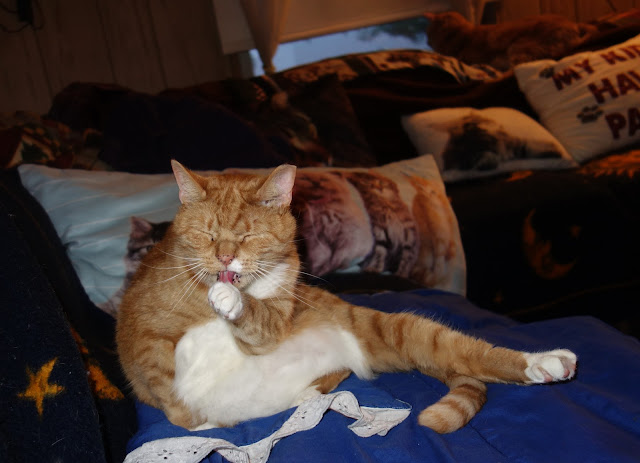I have already told you all about our other house kitties. So last, but certainly not least, our 'beckoning cat', Butterscotch. He has the most cutest mannerism of outstretching his front leg forward at you then reaching out at you with his paw - looking much like the Maneki Neko cat. Hence, his full name is Butterscotch Maneki (maneki is Japanese for "beckoning").
Butterscotch literally appeared at our doorstep only two years ago - a couple of months before we took in Ginger. My husband befriended him (or purrhaps it was the other way around?). I set up a cat bed and such for him in our garage and it wasn't long before we brought him inside the house and kept him separated from the other cats, as per usual, until we could get him in for an appointment at our vet.
It is worth noting that when my husband showed him to me, I told him that "This cat is a male." He said, "Nah, 'she' is too small to be a male." And, to that I replied, "Most orange tabby cats are male, you know." Lo and behold, the vet confirmed it and told us, "Well, to begin with SHE is a HE!" I was right - lol!
Of all of the cats we have shared our lives with, I must say that Butterscotch was the most adamant about being a house cat! Every single day and night for a couple of months he slept at the bottom of the step at the door between our garage and our kitchen.
He is by far one of the most gentle cats we have ever had. He never draws his claws on us or the other cats and only uses the cat scratching post in the living room.
The only worry we have regarding him is that our vet found a malignant tumor on his left back leg. We had it removed and were warned to keep an eye on his leg because our vet guaranteed us that this type of tumor WILL come back. We check him every couple of days. Needless to say, it is nerve-racking to say the least. This type of skin tumor is described as such:
Soft Tissue Giant Cell Tumors (Fibrous Histiocytomas)
Malignant fibrous histiocytomas are most frequently found in the skin and soft tissues of aged cats. They are most common on the lower legs or lower neck but may also occur at vaccination sites. They seldom spread to other locations in the body but tend to invade surrounding tissues and return after surgical removal. Because these tumors often recur, your veterinarian will remove the tumor and some surrounding tissue. This is necessary to provide your cat with the best possible outcome.
For a year now, we have been using turmeric powder for cats in Butterscotch's wet food in order to help fight his malignant tumor.
He is easy-going, affectionate, and quite the character. While Ginger is definitely a lap cat, Butterscotch is a "leg" cat - kneading your legs while you are sleeping then plopping himself down across your legs making himself at home.
He loves the other cats and snuggles up with them, most especially Ginger, all of the time ...
He has many nicknames, such as "my orange creamsicle kitty" and "my punkin' munchkin:". We simply adore him to the moon and back!






.JPG)




.JPG)

So sweet ❤❤❤
ReplyDeleteHe's sweet. Isn't it funny how many nicknames we have for the fur babies?
ReplyDeleteButterscotch is so sweet. It's a miracle that he showed up on your doorstep. He must have sensed that your home was a loving place and a safe refuge for kitties.
ReplyDeleteI've heard that turmeric is beneficial for tumors in humans, too.